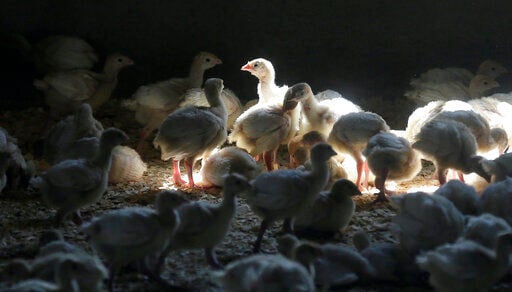DES MOINES — Farms that raise turkeys and chickens for meat and eggs are on high alert and taking steps to increase biosecurity, fearing a repeat of a widespread bird flu outbreak in 2015 that killed 50 million birds across 15 states and cost the federal government nearly $1 billion.
The new fear is driven by the discovery announced Feb. 9 of the virus infecting a commercial turkey flock in Indiana. The 29,000 turkeys in the flock were killed to prevent the spread of the virus.
The poultry industry and government officials say they have plans to more quickly stop the spread that were learned from 2015, but they’re urging caution since the virus strain is potentially deadly to commercial poultry. Egg, turkey and chicken prices could rise and availability could drop if birds at enough farms were to be infected.
“It’s definitely considered a period of high risk now that we have a confirmed case of highly pathogenic avian influenza in the commercial poultry industry,” said Dr. Denise Heard, a poultry veterinarian and vice president of research for the U.S. Poultry & Egg Association. “I feel positive that we can tackle this situation better and I have my fingers crossed that this will be an isolated case, however, I would hope for the best and be prepared for the worst.”
Health officials say no human cases of avian influenza viruses have been detected in the U.S. and the disease doesn’t present an immediate public health concern. The virus can spread from infected birds to people but such infections are rare and haven’t led to sustained outbreaks among humans.
The 2015 outbreak led producers to kill 33 million egg-laying hens in Iowa, the nation’s leading egg producer, and 9 million birds in Minnesota, the nation’s leading turkey producer, with smaller outbreaks in Nebraska, South Dakota and Wisconsin. The disease caused egg and turkey prices across the country to soar for months, with the cost of eggs up 61% at one point and prices for boneless, skinless turkey breasts rising 75% between May and July 2015.
The outbreaks were deemed the most expensive animal health disaster in U.S. history, costing the government nearly $1 billion for removal and disposal of infected birds and government indemnity payments to producers for the lost birds.
The strain now circulating is H5N1 and is related to the 2015 virus. It has been circulating for months in Europe and Asia and was found in wild birds in Canada a few weeks ago and in a commercial flock in Canada a week before the U.S. case was identified.
Migratory wild birds often carry strains of avian influenza and they’re often low pathogenic, which means they don’t kill the birds. Sometimes those strains can get into domestic flocks and mutate into more deadly viruses. The H5N1 now spreading from wild birds is already highly pathogenic, which means it is deadly from the start, said Dr. Yuko Sato, a veterinarian and assistant professor in the Department of Veterinary Diagnostic and Production Animal Medicine at Iowa State University.
The virus spreads easily from wild bird droppings and can be carried into commercial flocks on the feet of workers or on equipment, which is why high-level biosecurity protocol has been activated across the country in commercial operations. They’ve enacted new safeguards to prevent deadly bird flu infections, often referred to as HPAI, and isolate them when they occur.
In Iowa, a state with 49 million chickens, egg farmers are working with state and federal authorities to keep the disease out of their flocks, said Kevin Stiles, executive director of the Iowa Poultry Association and the Iowa Egg Council.
“IPA is maintaining open communications specifically related to biosecurity best practices and is offering surveillance testing. We are confident in our producers preparedness and ability to manage their flocks,” he said.


